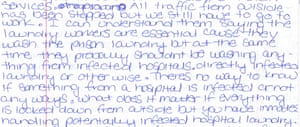Some north-west states were informed of social distancing practices, but accounts from inmates and advocates say their implementation may be scattered
- Coronavirus – live US updates
- Live global updates
- See all our coronavirus coverage

Photograph: Joe Castro/AAP
A handwritten plea from an Oregon prisoner to his family a week ago describes conditions in the state’s prison system as a public health catastrophe waiting to happen, amid a lack of social distancing practices in the system’s moneymaking arm.
“There is no way it should be legal for a few hundred inmates to be forced to work around each other so close with the potential risk and how far [the coronavirus] could spread,” wrote the inmate at the Two Rivers correctional institution (TRCI) near Umatilla, Oregon. The Guardian is withholding the inmate’s name due to his fears of retribution from prison authorities.
“I see all the stay at home orders of non-essential workers and can’t believe we are still being made to work,” the inmate added.
Prison protests in Oregon and Washington on Wednesday night highlighted growing concerns among inmates about the way authorities in the Pacific north-west states are managing the safety of incarcerated people amid the coronavirus pandemic.

State government documents obtained by the Guardian suggest that authorities in at least some of the states were informed of best practices recommended by public health authorities, but accounts from inmates and advocates indicate their implementation may be scattered at best.
The prisoner, who is held in minimum security at Two Rivers correctional institution, said that inmates are being exposed to unsafe conditions as they perform work in facilities run by Oregon Correctional Enterprises (OCE), the state’s prison industry program. OCE was set up by a series of 1990s ballot measures “to operate like a private sector business”; on average inmates reportedly get paid $1.25 an hour working for the program.
Although the inmate wrote that TRCI has introduced some social distancing measures at the prison, including by staggering inmate exercise and dining and barring outside visitors (“no visitors, no education teachers, no church services”), he argued that these efforts are being undone by the working conditions in OCE’s wood shop and its laundry facility.
Work at the facilities has continued even after proclamations by the governor regarding social distancing, and as major clients like schools and outdoor recreational facilities are on lockdown.
“Several laundry workers and wood shop workers have been sick with colds but none have been tested only examined by nurses and told to stay at home until they feel better,” he wrote.
According to his letter, inmates at work at the facilities are not able to practice adequate social distancing, and are being lined up and patted down on their way in and out of the workshops, with some but not all supervisors wearing gloves. They worry that workers at the laundry facility are handling hospital linen that is potentially contaminated with the virus.
In the OCE break room, he said, inmates are “shoulder to shoulder”, and unable to socially distance. Large numbers of prisoners are handling hot water and milk dispensers, which are not being frequently cleaned. OCE workers only have access to one small bathroom.
“We all use the same bathroom 5 stalls and one urinal,” the inmate wrote. “We all touch the same soap dispenser and same buttons to wash hands after using bathroom. We also all touch the same spray bottles of disinfectant to spray off toilet seat before you use it. We all touch the same door,” he said.
Inmates are being threatened with punishment by TRCI if they refuse to work OCE shifts, he said in the letter. He told his mother that inmates refusing to work risked being sent to more crowded medium-security accommodation, and that if he would quit the job he would risk losing his honor housing, benefits and special privileges.

Though independent of Oregon’s department of corrections (ODOC), as a quasi-government business, OCE uses inmate labor in facilities within prison complexes to make goods like furniture and signage, often for schools, outdoor recreation sites and the prison system itself. OCE workers also perform services like laundry.
OCE’s director, Ken Jeske, and representatives of the ODOC offered no substantive reply to the Guardian’s repeated, detailed questions on Scott’s allegations. He said OCE’s communications director, Jennifer Starbuck, “will follow up with DOC on your request in a reasonable amount of time”.
In correspondence with an inmate’s concerned relative on 27 March, however, Starbuck emphasized OCE’s financial requirements, and claimed that continuing work made the prisons safer.
“All of the OCE staff working are essential,” Starbuck wrote.
She continued: “OCE funding comes from the services and products we produce, through the work and training opportunities we provide to the AICs [Adults in Custody] in our shops. Keeping the AICs engaged in work helps keep the prisons safer (they are occupied and have something to focus time and attention to). All of the work assignments in OCE are voluntary.”
Starbuck offered no evidence for her claims about work and safety, and OCE did not respond to specific requests for such evidence.
In an issues brief and in emails between Starbuck and the concerned relative, OCE acknowledged that hospital laundry is being handled by its workers, but claims that its processes comply with CDC directives.
“OCE laundry follows all guidelines set forth by the CDC for washing and drying of healthcare linen. Laundry is washed in accordance with decontamination practices recommended by the CDC,” the March 2020 issue brief says.
ODOC’s approach to the coronavirus crisis has been uneven and confused, Juan Chavez, the director of the Civil Rights Project at the Oregon Justice Resource Center, told the Guardian. Chavez is leading a class-action suit launched against ODOC that alleges that the department has “willfully and wantonly ignored the public health threat caused by this global pandemic”. ODOC did not respond to the Guardian’s repeated request for comment on the suit.
“Half-measures” have been adopted in some places, Chavez said, but overall the system showed a “patchwork of solutions”. He added: “It’s one step forward, three steps back.”
Meanwhile, in the neighboring state of Washington, an outbreak in Monroe prison led to a riot on Wednesday, as prisoners objected to what they saw as inadequate protections in the facility. Several prisoners at Monroe have tested positive for Covid-19.
But last month Washington’s department of health (WDOH) circulated a literature review outlining scholarly literature and a body of guidelines from other states and countries indicating best practices and ways to prepare for epidemics in prison settings.
The literature, and the document itself, spells out a list of dangers that reflect the concerns of prisoners, including the Oregon inmate.
“Key concerns for correctional facilities and pandemic preparedness include crowding, shared living spaces, high turnover, population flow patterns, health care resources, staff absenteeism, and interaction with the general population”, the literature review says.
The document lists a number of studies and guidelines which offer clear and specific preparations and action plans for prisons.
A 2006 document, Infectious Diseases in Corrections Report, contains a section entitled Pandemic flu preparedness and response in corrections facilities, produced by a researcher at the Institute for Biosecurity at Saint Louis University school of public health.

The document counsels that prisoners are especially vulnerable in pandemics.
“During an influenza pandemic,” the document says, “inmates may be particularly vulnerable to infection due to the close quarters in which most live as well as the relatively high prevalence of co-morbid health conditions.”
It says that “prison overcrowding – a serious problem in many facilities – is a major contributor to disease spread”.
It goes on to warn about anticipated problems like access to hospitals, staff absenteeism and the difficulty of isolation and treatment in a prison setting.
A 2009 document collated in the literature review, Pandemic Influenza Preparedness and Response Planning, was produced by a consortium of US correctional medical officers and scientists.
It offers clear guidelines for preparing correctional facilities for pandemics, including: “Assess the need to purchase personal protective equipment (PPE) such as gloves, surgical masks, respirators, and protective clothing”; “Ensure that alternative supervision strategies are compatible with the pandemic plans of public health, law enforcement, the judiciary, and (other) correctional facilities”; and “minimize the number of face-to-face contacts”.
Neither WDOH nor WDOC responded to repeated, detailed requests for comment on whether they had jointly discussed this literature since the review’s release on 3 March, and whether WDOC had implemented any of the recommendations and guidelines.
The not-for-profit Columbia Legal Services this week filed an emergency motion to force Washington to take greater measures to address the outbreak in Monroe prison. Nick Straley, an attorney and assistant deputy director of advocacy with the organization, said: “There’s an almost unanimous sense among public health officials that releases have to occur in order to reduce the number of people in prisons in Washington.
“We’ve got another facilities that are overcrowded. We’ve got people sleeping on the floor of cells designed for two people. They’re crammed with people, people are on top of each other,” he said. “To the extent that department of corrections to date has refused to release anyone, we think that they have clearly not stepped up and done what’s essential.”



